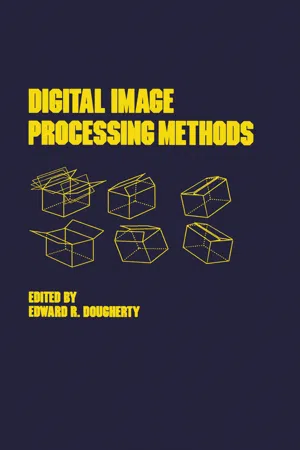
This is a test
- 504 pages
- English
- ePUB (mobile friendly)
- Available on iOS & Android
eBook - ePub
Digital Image Processing Methods
Book details
Book preview
Table of contents
Citations
About This Book
This unique reference presents in-depth coverage of the latest methods and applications of digital image processing describing various computer architectures ideal for satisfying specific image processing demands.
Frequently asked questions
At the moment all of our mobile-responsive ePub books are available to download via the app. Most of our PDFs are also available to download and we're working on making the final remaining ones downloadable now. Learn more here.
Both plans give you full access to the library and all of Perlego’s features. The only differences are the price and subscription period: With the annual plan you’ll save around 30% compared to 12 months on the monthly plan.
We are an online textbook subscription service, where you can get access to an entire online library for less than the price of a single book per month. With over 1 million books across 1000+ topics, we’ve got you covered! Learn more here.
Look out for the read-aloud symbol on your next book to see if you can listen to it. The read-aloud tool reads text aloud for you, highlighting the text as it is being read. You can pause it, speed it up and slow it down. Learn more here.
Yes, you can access Digital Image Processing Methods by Edward R. Dougherty in PDF and/or ePUB format, as well as other popular books in Computer Science & Digital Media. We have over one million books available in our catalogue for you to explore.
Information
1
Nonlinear Filters
Jaakko Astola
Tampere University of Technology
Tampere, Finland
Tampere, Finland
Edward R. Dougherty
Rochester Institute of Technology
Rochester, New York
Rochester, New York
I. Median Filtering
Semantically, nonlinear filtering concerns all image-to-image operators that are nonlinear, and since digital images do not form a vector space, all image filtering. Nonetheless, insofar as classical linear techniques are adapted to image filtering, linear methods do compose a large segment of image filtering. Moreover, certain types of inherently nonlinear filters have been studied extensively and these concern us in the present chapter.
Linear filters are attractive for several reasons: they possess useful algebraic properties; their operation is easy to understand; via Fourier transform they have a direct relation to frequency representation; their statistical properties are well understood; and there exist elegant, closed-form solutions for finding statistically optimal linear filters. Yet requiring linearity imposes a strong constraint on filter design. Although the linear constraint might be appropriate for some image models, for many it is certainly disadvantageous. The example cited most often is the manner in which linear filters blur edges, which in images often contain key information; on the other hand, median filters, which are nonlinear, leave edges invariant. There any many other instances where linearity is a poor filter requirement, albeit one that is mathematically attractive. As a result, more recently much attention has been focused on the analysis and design of nonlinear filters for accomplishing various image-processing tasks.
The present chapter is broken into two parts. The first considers median filters, and the second, morphological filters. As intuitively conceived, median filters are numerically based, and morphological filters are shape based. Median filters arise from classical maximum-likelihood estimation and from certain operations on logical variables; morphological filters arise from fitting shape probes within larger shapes. Nevertheless, there is a close relation between the types of filtering and they form a unified, coherent theory. We begin with median filters, proceed to stack filters, then to shape-based morphological filters, and...
Table of contents
- Cover
- Half Title
- Title Page
- Copyright Page
- Series Introduction
- Preface
- Table of Contents
- Contributors
- Introduction
- 1. Nonlinear Filters
- 2. Morphological Segmentation for Textures and Particles
- 3. Multispectral Image Segmentation in Magnetic Resonance Imaging
- 4. Thinning and Skeletonizing
- 5. Syntactic Image Pattern Recognition
- 6. Heuristic Parallel Approach for 3D Articulated Line-Drawing Object Pattern Representation and Recognition
- 7. Handwritten Character Recognition
- 8. Digital Image Compression
- 9. Image-Processing Architectures
- 10. Digital Halftoning
- 11. Glossary of Computer Vision Terms
- Index